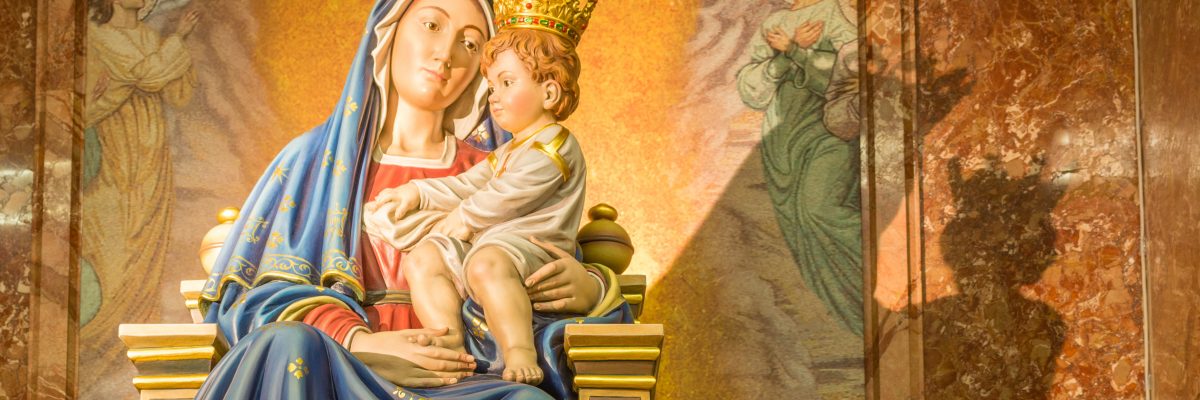
Have you ever been at a family gathering and one of your elders or siblings tells a story of what you were like when you were little?
This happened to me just this Thanksgiving. My brother, who likes to embarrass me, told everyone at the table—my abbot, my prior, and the others there—examples of how I used to act when I was little. The stories were in fact not so embarrassing (they even put me in a good light), just a bit personal. And they really matched my present personality, so everyone else who heard them found them easy to believe.
I won’t share the details, but I am sure we all get the situation and the point: there is so much more about us than what the people who know us see and understand. But if they were to learn more about us from the time before they knew us, they would see the continuity with our present personality. And they would enjoy being in on the private details of our story.
Everyone likes to hear stories of great public figures from the time when they were just little people, hidden from the world. I can remember the story of little George Washington and the cherry tree. As a kid, I believed it, and given his later accomplishments I can say with the Italians, Se non é vero, é ben trovato: “Even if it didn’t happen that way, it still rings true.” (If any current day readers—millennials and other deprived generations—have never heard the story of George and the tree, they should “google” it and find out. Then they will realize how much richer was the fare that was served up to prior generations, and they might understand their parents a little better!)
There are no individuals in human history whose lives have generated more interest than Jesus and Mary. From the earliest days of the Christian era the faithful have been eager to follow the details of their lives and have sought to satisfy their devout curiosity with more scenes of their lives, and in particular of their childhood, than are available in the canonical scriptures.
Pope Benedict XVI did us all a favor by publishing his little volume on the so-called “infancy narratives” in the Gospels. He largely vindicates the traditional story against the rationalizing denials of modern scholars. The fact is that the most widely read account of the early life of Our Lady and the Savior in the ancient Church was not a canonical book of Scripture but the Protoevangelium of James, which gives an account of the birth and childhood of Our Lady and of her annunciation and the birth of the Savior. There are more early manuscripts of this work than of any of the Gospels.
Though not inspired Scripture, the Protoevangelium represented the popular traditions regarding Jesus, Mary, and John the Baptist coming from the Jewish Christian context of the church in Palestine before the Romans definitively drove out the Jews under the emperor Hadrian. Some elements of these stories were accepted as correct; others were rejected. Some recent scholarship, even by non-Catholics, has shown that many details of this purported work of St. James are historically credible beyond what modern scholars had been willing to believe
The elements that were judged reliable came in to the Church’s worship and remain there until today. Just as the calendar of fixed feasts has a cycle that traces Our Lord’s infancy throughout the year (March 25 his conception, May 31 the Visitation, December 25 his birth and so on), so too there is a little cycle for Our Lady (December 8 her conception, September 8 her birth, November 21 her presentation in the temple) and also of John the Baptist (his conception on September 23 in the Byzantine rite, which is a commemoration in the martyrology of his parents, Zachary and Elizabeth in the Roman rite; June 24 his birth, and August 31his martyrdom). The Immaculate Conception of Our Lady, the solemnity we celebrate today, came into the calendar as the commemoration of the St. Ann’s conceiving of her in her old age after being assured by an angel, along with her husband St. Joachim, that she would bear a daughter.
Popular accounts of the lives of the saints often have great historical value and theological and spiritual influence. We should not reject them by a kind of minimalism that is always asking whether the particular story is required for belief. When we love and admire an historical figure and we read his biography, we are disposed to believe what we read because it goes along with what we know about him. To be sure, one detail in the biography or another might be incorrect or exaggerated, but overall we are disposed to believe the whole story. Catholics should stop the reflexive dismissal of ancient traditions just because they are not “defined” teachings. This tendency is akin to reducing a biography to the minimum available in legal documents. It is not reasonable, it is not human, and it is boring. Your life is a lot more than what you can get on a web document search!
What is certain about Jesus and Mary is that we love them with all our hearts, and so we are very willing to believe all kinds of good things about them that others may tell us. Take a look at the lengthy and thoughtful meditations of the saints on the lives of Jesus and Mary. There is St, Bridget of Sweden, there is St, Gertrude, there is Margery Kempe, there is St, John Eudes, there is Venerable Mary of Agreda, and Blessed Ann Catherine Emmerch. Sophisticated people can scoff at these latter two, but Emmerich is a minor classic of Romantic German literature, highly regarded by Gerard Manley Hopkins and by Jacques and Raissa Maritain, and Mary of Agreda was the favorite reading of St. Junipero Serra, St. Katherine Drexel, and the newly beatified (less than a month ago!) Bl. Solanus Casey. For this Advent, we might take a look at some of these things. (There is a fine collection of them called The Life of Mary as Seen by the Mystics, published by Angelico Press.)
These works present highly imaginative accounts, but with much spiritual insight and often theological depth. Indeed, the great Abbot Gueranger, who practically created the liturgical movement and the revival of religious life in the nineteenth century, wrote a whole book vindicating Mary of Agreda’s Mystical City of God. Too bad for Bl. Solanus Casey, whose minimalist superiors made him stop promoting it to the people who came to him. It turns out that it was not the simple Solanus who was ignorant and unlearned, but his superiors.
After all the great Gueranger, who wrote a book defending these long and baroque meditations, was the one to whom Bl. Pope Pius IX entrusted the formulation of the dogmatic definition of the Immaculate Conception! Here is proof that the minimum of dogmatic precision does not exclude a maximum of loving devotion and willingness to believe every good thing of our dear Mother, the Virgin Mary, the daughter of old Joachim and Ann, spotless in her conception. May the beloved apostle John, who took Our Lady into his home, make us understand the meaning of his words, “Love believeth all things.”



